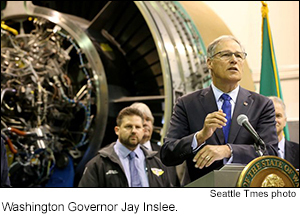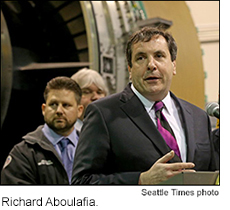Published Wednesday, June 6, 2018 in The Seattle Times
Boeing’s Best Option for Building Next Jet is Washington, Says State-Backed Study
By Dominic Gates
The conclusion of an aerospace-industry study released Wednesday will not come as a shock and will certainly be dismissed as biased by some outside Washington state.
Still, Richard Aboulafia, a respected aerospace-industry analyst and the study’s lead author, asks you to hold your skepticism.
Before Boeing’s decision on where to build its next jet, the state-commissioned study concludes that the best site in the U.S. for aerospace manufacturing is … Washington state.

Aboulafia, a vice president at the Teal Group consulting firm in Fairfax, Virginia, said his 42-page report is based on independent, rigorous data measuring factors relevant to aerospace production, including costs, tax structure, skilled- labor availability and global trade connectivity.
His conclusion: “Strictly by the numbers, Washington state is in a class by itself.” Aboulafia added, “It has weaknesses, but in the overall ranking, nothing comes close.”
Aboulafia said he took no input from anyone at the state or at Boeing. Instead, he and his co-authors gathered copious amounts of government and industry data and ranked the 50 states on carefully weighted metrics.
“This was meant to be as neutral and clinical as possible,” he said.
“You can try this at home. If you like, you can assign different weights to some of the factors. You won’t meaningfully change the outcome.”
In a press conference inside an aircraft-maintenance-training hangar at South Seattle College, Gov. Jay Inslee noted that in the overall scoring, Washington finished way ahead of its nearest rivals.
There was a large gap between Washington and the next three states in the rankings, Ohio, North Carolina and Kansas.
“This isn’t a close call,” Inslee said. “We win this going away.”
He added that all the advantages the state offers should be a sufficient incentive for Boeing to choose Washington without asking the state for more.
“We are not approaching this as a supplicant,” Inslee said. “We are approaching this as a confident state with a confident group of workers.”
The second-lowest state in overall costs
The study was commissioned by the state as it tries to prepare the way for Boeing’s choice of a site to build its proposed “New Midmarket Airplane” (NMA), which the company is expected to launch in six to nine months and is dubbed by many the 797.
The state has had to compete for every new or derivative Boeing aircraft-production line since 2003, when the jetmaker held its first state-versus-state search for a site to build what became the 787.
Though Everett won that competition, six years later Boeing picked North Charleston, South Carolina, for the site of a second 787 assembly line — making clear that the Puget Sound region was not its only option.

In 2011, Boeing extracted a long-term labor contract from the Machinists union to place the 737 MAX assembly work in Renton. In 2014, the company again pressured the Machinists, who gave up their traditional pension plan, before agreeing to build the 777X in Everett.
Both the MAX and the 777X are derivatives of jets built here, so putting them anywhere else would have been difficult. But the NMA competition will be the first for an all-new jet since the 787, which makes the outcome less predictable.
Aboulafia’s study was paid for by a coalition of state business and labor interests, including the two Boeing unions, the International Association of Machinists (IAM) and the Society of Professional Engineering Employees in Aerospace (SPEEA).
Thanks to Washington state’s aerospace-industry tax breaks, which were expanded to win the last Boeing competition, for the 777X, it ranked as having the fifth-lowest taxes among the 50 states.
And it ranked as the second-lowest state, bettered only by North Carolina, in the overall cost of labor, energy, materials and construction.
How did Washington come out so well in terms of labor costs versus states where wages are much lower?
Aboulafia said the study didn’t just identify the lowest cost — with such a simple metric, “Bangladesh would look good” — but instead measured labor productivity, specifically the dollar amount of payroll necessary to produce $1 of aerospace revenue.
Jon Holden, president of the IAM District 751, welcomed this focus on the output of labor rather than the wage rate.
“What they found is that machinists and engineers here in Washington are very efficient and productive,” Holden said. “We produce more aerospace output per dollar cost of labor than almost anywhere else.”
In a separate measure of the availability and skill level of the available workforce, Washington ranked second from the top.
And the state ranked high in terms of support for research and innovation.
On the sidelines of the press conference, Holden echoed Inslee’s position that the advantages to Boeing from placing work here mean that Washington is in a strong position.
He said if Boeing wants to talk about a contract extension to ensure labor peace in the early years of the NMA, his members first would have to vote to approve entering negotiations.
If they did so, he’d discuss an extension — but he added that following the deep cuts in 2014, the machinists would not be open to further concessions.
South Carolina not highly ranked
Besides Washington, Ohio, North Carolina and Kansas, the top 10 in the report’s rankings also included rival states from the south, Texas at No. 8 and Alabama at No. 10.
Perhaps surprisingly, South Carolina, a major Boeing commercial-airplane manufacturing site and seen by many as this state’s main rival for the jetmaker’s next airplane, came in well down the overall rankings at No. 22.
“On the basis of this data, I’m not convinced South Carolina is the main competition,” said Aboulafia.
He said the absence of a large enough pool of skilled labor weighs against that state.
While South Carolina proved it could set up a secondary manufacturing site, that required parachuting in experienced people from Washington and elsewhere to get it going, Aboulafia said.
He argued this approach wouldn’t scale easily to provide the talent needed to operate the primary assembly site for a new airplane, complete with an ecosystem of major suppliers and subsystem fabrication facilities.
In contrast, neighboring North Carolina “looks really good,” he said.
That state is the only one where a manufacturer set up the primary assembly facility for an all-new commercial airplane at a greenfield site, although certainly a much smaller jet than a Boeing airliner.
The Hondajet, a small business jet designed in Japan, is built in Greensboro, North Carolina.
“I think the Japanese looked at the same numbers we have,” said Aboulafia.
Although it wasn’t part of his report, Aboulafia also said that Boeing’s new $1 billion composite-wing manufacturing facility in Everett is probably a key advantage for this state, since the 797 is expected to have an all-composite airframe.
Boeing Chief Executive Dennis Muilenburg told The Seattle Times in an interview in January that “doing a composite wing that leverages that facility would make a lot of sense.”
Aboulafia agreed. “There’s a lot of infrastructure and investment in the 777X wing center. If you could spread it over two key airplane programs, that would help a lot,” he said.
If the wing of the 797 is made in Everett, the argument for putting final assembly there, too, looks solid.
Asked if the data indicates any weaknesses that could be addressed to improve Washington state’s chances, Aboulafia identified education and training as well as road infrastructure.
Yet he said those are areas that the state can fund, developing apprenticeship programs and targeted infrastructure projects, for example.
In contrast, another state without an experienced aerospace workforce cannot quickly produce one by throwing money at it.
“A skilled workforce takes generations,” he said.
Aboulfia’s report can also be read with an inverted focus: not to persuade Boeing to build its plane here, but to concentrate the state’s mind on the benefit that would bring.
The study points out that Washington generates twice the aerospace sales of any other state.
Washington also exports more aerospace products than California, Texas, Georgia, Florida, South Carolina, Arizona and Alabama — combined.
And Washington has the highest density of aerospace engineers of any state.
All of those superlative measures are due to Boeing’s presence. If the next plane goes elsewhere, those metrics will shift.
Speaking on the sidelines of Wednesday’s press conference, Inslee expressed optimism about the state’s chances, given especially the experienced workforce, the favorable tax system and the established supply chain ecosystem.
“It’s appropriate to have a reasonable expectation that the decision will go this way,” Inslee said.